
After being dealt a potentially devastating blow by DoorDash, Goldbelly is diversifying its business. On Tuesday (Nov. 9), the New York company, known for shipping local restaurants’ foods to consumers nationwide, announced the launch of Goldbelly TV, a platform for shoppable food content including livestreams and prerecorded videos featuring chefs and restaurateurs.
“We’ve all been enthralled watching food content for decades, yet there’s always been a disconnect for consumers,” Joe Ariel, founder and CEO of Goldbelly, said in a statement. “Though you could see the food on the screen, and it could be the most delicious thing you’ve ever seen, there was never a way to taste it. We’re finally bringing the idea of ‘Taste-o-Vision’ to life, giving people the first truly immersive food experience.”
The announcement came the day after DoorDash announced its new Nationwide Shipping feature, which effectively replicates Goldbelly’s business model.
DoorDash’s audience is orders of magnitude larger than Goldbelly’s, making this new launch a very real threat. By launching this content suite, Goldbelly has an opportunity to build out its brand experience beyond its online shop, potentially differentiating itself from its far larger competitor.
“For the first time ever, chefs will be able to connect with their fans directly,” said Art Edwards, head of the company’s new production arm Goldbelly Studios. “Goldbelly TV is just the first step for us in democratizing how chefs and food makers reach new audiences nationwide — all while making the world a more delicious place.”
Wendy’s Taps Ghost Kitchens to Circumvent Construction Challenges
As businesses struggle against supply chain constraints and labor shortages, building a restaurant from the ground up becomes more difficult. As a result, Wendy’s is turning to its delivery-only ghost kitchens partnership with REEF in some locales to help the company meet its ambitious unit growth goals.
“You would expect a 5% to 6% growth rate next year, and the majority of that is driven by REEF, since the 700 units [planned over the next five years] could be evenly split across all years,” Wendy’s president and CEO Todd Penegor told analysts on a call Wednesday (Nov. 10) discussing the chain’s third-quarter earnings.
Chief Financial Officer Gunther Plosch added that these restaurants “obviously have super-fast construction types,” making them far easier to open than traditional restaurants, given the current constraints.
These nontraditional restaurant openings come as the demand for digital delivery ordering surges, relative to pre-pandemic sales. PYMNTS’ study The Bring-It-To-Me Economy: How Online Marketplaces And Aggregators Drive Omnichannel Commerce, created in collaboration with Carat from Fiserv, found that 58% of consumers are ordering restaurant food online more often than prior to March 2020.
See also: Bring-It-To-Me Economy Ascends As Consumers Embrace Home-Centric Lifestyles
In fact, 48% of restaurant customers are ordering from restaurants’ direct delivery channels more often, and 46% from third-party aggregators.
Penegor noted that in addition to rolling mobile ordering out to new markets, the company also aims to “integrate new delivery partners” in its effort to grow its digital sales.
According to data from PYMNTS’ 2021 Restaurant Readiness Index, created in collaboration with Paytronix, 23% of chain quick service restaurants’ (QSR) sales now come through third-party aggregators, which is nearly twice the share (12%) coming through their direct ordering delivery channels.
Read more: QSRs’ Lagging Loyalty-Reward Investment Hurts Innovation and Sales
Inspire Brands Opens Its First Multi-Brand Ghost Kitchen
Also in ghost kitchen news, Inspire Brands — the parent of Dunkin’ and Baskin Robbins, among other popular restaurant brands — announced Tuesday (Nov. 9) the opening of its first multi-brand, delivery-only location.
Featuring foods from Arby’s, Buffalo Wild Wings, Jimmy John’s, Sonic Drive-In and Rusty Taco, the company promises that this so-called Alliance Kitchen will cut labor cost by 54% and equipment costs by 45%.
“Inspire is uniquely positioned to operate a concept like Alliance Kitchen, the first ghost kitchen launched, owned, and operated by a multibrand restaurant company,” Stephanie Sentell, senior vice president of restaurant operations and innovation, said in a statement.
“We look forward to continuing to test and learn with Alliance Kitchen as we find new ways to provide our guests with convenient, digital-led dining experiences.”
Red Robin Taps Loyalty Upgrades to Drive Q4 Success
Red Robin is about to launch a new loyalty program, aiming to improve its segmentation capabilities to drive digital sales. On Wednesday (Nov. 10), CEO Paul Murphy told analysts on a call discussing the chain’s Q3 earnings that the company aims to leverage this new loyalty program to boost online conversion and increase spending.
“In Q4, our new loyalty platform powered by Punchh, a proven player in the restaurant space, will enhance our loyalty campaign and communication capabilities,” Murphy said. “Our improved and more relevant integrated digital guest experience is expected to soft-launch in Q4 and drive incremental frequency, traffic and guest check.”
According to the Restaurant Readiness Index, consumers rank the availability of loyalty rewards programs as the single best way to incentivize them to spend more on their orders.
Research from the July-August edition of PYMNTS’ Delivering on Restaurant Rewards report, created in collaboration with Paytronix, finds that 72% of table-service restaurant customers want to be rewarded for their loyalty with free food, and 57% want to be rewarded with customized coupons or discounts.
Related news: Two-Thirds Of Consumers Find Restaurant Rewards Impersonal